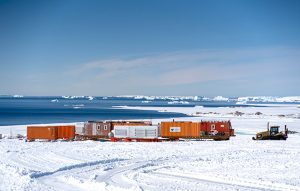A 1,100 km raid to measure Antarctic climate variability
To better characterize the atmospheric water cycle over Antarctica, in order to better predict the evolution of the ice cap and sea levels in the context of climate disruption: this is the challenge of the Awaca project involving teams from LSCE (CEA/CNRS/UVSQ), who are deploying their measuring instruments along an 1100 km route. A real logistical and scientific challenge.
December 2, 2024: the scientific raid of the Awaca project, designed by the Polar Institute and to which LSCE teams are contributing, begins to deploy its instruments. It will travel up to 1100 km along an axis aligned with the trajectory of air masses transporting moisture from the ocean to the Antarctic interior. By mid-January 2025, field instruments will be collecting precise data on cloud formation and precipitation on an unprecedented scale, contributing to the accumulation of snow on the surface.
In the context of climate disruption, ocean volume is particularly dependent on the amount of water stored in the form of snow and ice in the Antarctic ice cap: if the ice cap loses mass through melting, sea levels rise; if it gains mass through snow accumulation, sea levels fall. Yet the physical processes at work remain poorly understood. Ultimately, the aim of the Awaca project launched in 2020 is to reconstruct Antarctic climate variability over the last millennium and optimize new-generation numerical models to predict variability over the next 100 years.
Autonomous instrumentation capable of continuous operation for three years in extreme Antarctic conditions
The result of three years’ technical and instrumental development work, the specially-designed observation systems will take continuous readings. For three years, they will characterize, monitor and record the physics and dynamics of the atmospheric column (clouds and precipitation), the isotopic composition of surface snow, and surface variables (temperature, humidity, wind, blown snow). Annual maintenance will be carried out by the teams during the summer campaigns, via the deployment of control raids.
“There are a lot of technological challenges involved, not least in getting the instruments to work completely autonomously in extreme conditions: on the coast, there’s a lot of wind, with peaks of 200 km/h, and the further inland you go, the lower the temperatures – down to -80°C in winter”, explains Valérie Masson-Delmotte, the CEA paleoclimatologist who co-initiated the project.
The Awaca project is the subject of an ERC Synergy co-sponsored by CEA, CNRS, École polytechnique de Paris and École polytechnique fédérale de Lausanne.
See (in french) : https://awaca.ipsl.fr/

